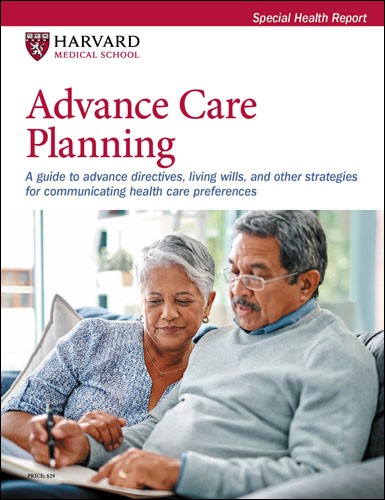Reframing hospice and palliative care
Sometimes viewed as "giving up," these crucial services instead offer life-affirming benefits during difficult times.
- Reviewed by Toni Golen, MD, Editor in Chief, Harvard Women's Health Watch; Editorial Advisory Board Member, Harvard Health Publishing; Contributor

When Jimmy Carter decided earlier this year to opt for hospice care at his Georgia ranch after a series of hospital stays, the 99-year-old former president made a deliberate choice: no more trips to the ER, and no more aggressive, time-consuming treatments.
Instead, the revered statesman reached for more of the good stuff: time with his cherished wife of 77 years, Rosalynn. Moments relishing their large extended family. And more peanut butter ice cream, his favorite treat.
After a life well lived, Carter clearly saw himself at a crossroads. And his decision epitomized a shift in understanding of the aim of hospice itself — not as an act of "giving up," but instead a choice to prioritize comfort and make the most of everyday moments. But many people are still missing this key insight into hospice — and the related practice of palliative care — that could improve their ability to live the way they want when they're seriously ill, Harvard experts say.
"Choosing hospice doesn't mean you're giving up getting medical care; it's focusing on comfort with the medical care you do receive," says Dr. Carine Davila, a palliative care physician at Harvard-affiliated Massachusetts General Hospital.
"Maybe we can't control a disease, but we can control where we are and who we're with," agrees Sarah Byrne-Martelli, a board-certified chaplain and bereavement coordinator in the Division of Palliative Care and Geriatric Medicine at Massachusetts General Hospital. "When people are offered the choice of being stuck in a hospital or being home with their family and dog, watching their favorite shows and eating their favorite meals, they often choose the latter. We can help them paint a picture of what they want the end of life to look like, and for most, it's not being stuck in an ICU."
Differences in approach
Fundamental to understanding your choices is knowing the difference between palliative care and hospice. The two overlap, but aren't the same.
Palliative care focuses on symptom relief and management for people who are seriously ill at any stage, not just the end of life. It can also be offered alongside potentially curative treatments. "Palliative care offers an extra layer of support to patients, families, and the teams taking care of them," Dr. Davila says.
Hospice, on the other hand, makes the dying process more comfortable for people with serious illnesses. While this approach is often offered to those expected to survive six months or less, many people opt for hospice care even when the end of life may be further off. This can include people with terminal conditions such as late-stage cancer, but also those with several chronic illnesses such as kidney disease, diabetes, or heart failure that together can shorten life. Like President Carter, some people who enter hospice have also endured multiple hospitalizations, becoming weaker with each.
"Palliative care is a bigger umbrella, where we help people at all stages of illness, while hospice is focused on the end stage of life," Dr. Davila says.
Layers of support
Hospice care occurs at two main levels. "Routine" hospice care, which applies to the vast majority of hospice patients, involves a broad team supporting them in their home with medication, medical equipment, nurse visits, and social and spiritual support. Meanwhile, patients who need round-the-clock nursing care to stay comfortable can be cared for in either a hospital-based hospice unit, dedicated hospice facility, or nursing home.
The hospice team equips patients' homes with items such as a hospital bed, shower chair, and assistive devices such as canes, walkers, or wheelchairs. It also makes sure certain medications, such as for pain, are ready and waiting. In addition to such support, hospice typically also offers a 24/7 hotline enabling patients and families to ask questions at any hour.
"It's a holistic way of looking at total pain. You might be having physical, spiritual, emotional, or social pain," Byrne-Martelli says. "We see you as a whole person."
Tough decisions
Long-established research shows that palliative care can extend life. A seminal 2010 study in The New England Journal of Medicine suggested that patients newly diagnosed with terminal lung cancer who began receiving palliative care along with their cancer treatment lived nearly three months longer than others who received standard cancer care alone. Patients receiving palliative care were less likely to need aggressive cancer treatments at the end of life, although that option remained available.
The palliative care patients were also happier, more mobile, and in less pain as their time shortened. "With better symptom management, people may tolerate their treatments better and may be able to continue on them longer," Dr. Davila notes.
For now, aggressive medical care remains common at the end of life, according to a February 2023 study published in JAMA Network Open. Researchers analyzed five years of cancer registry data, nursing home assessments, and Medicare claims to evaluate "aggressive end-of-life care" such as repeated emergency room visits or ICU care among 146,000 older adults with advanced cancer (average age 78, 48% women). Most received aggressive treatment in their final 30 days of life, and one-quarter underwent cancer treatment such as surgery, radiation, or chemotherapy.
"Part of it is that people opt for aggressive treatment because they're hoping for a miracle and wrestling with grief, fear, and uncertainty. The tricky thing, of course, is that healing can occur in different ways and not always on our timeline," Byrne-Martelli says. "When we can talk about what it means to live well and what their spiritual values are, sometimes people can say, 'I don't need to try this fifth surgery because it might actually cause more suffering. Maybe it makes more sense to put my energy toward comfort and quality of life.'"
Healing actions
One of the biggest under-recognized benefits of hospice care is the ability to carry out your own priorities. Team members ask patients what they want and support them toward reaching those goals — whether that's to attend a grandchild's graduation or wedding, take a trip, or just walk their favorite path in the woods each day.
"Sometimes parents want to spend time creating a memory book, or writing letters to their children to mark important future milestones, knowing they won't be there for some of those life events," Dr. Davila says. "Those are examples of really powerful meaning-making for patients and families that also create things these families will be able to hold on to."
Byrne-Martelli took weekly walks with a man in hospice care whom she visited for many months. He spent that time telling her about "his life, his kids, his regrets, and his joys," she recalls. "It was almost like he was taking the time to very intentionally wrap up his life. Having the space to share that with someone can be really healing in and of itself."
How to approach hospice care for yourself or a loved oneIf someone you know has been told they have six months or less to live, it's wise to consider hospice sooner rather than later—as grueling as that decision may be, Harvard experts say. "That type of prognosis should be an automatic trigger to think about it," says Dr. Carine Davila, a palliative care doctor at Massachusetts General Hospital. Considering hospice care doesn't mean you have to follow through, says Sarah Byrne-Martelli, a chaplain and bereavement coordinator at Massachusetts General Hospital. "You can always meet with a hospice admission nurse to get more information.it doesn't mean you have to sign up. You don't have to commit to anything, but they can share what services they offer." Harvard experts offer these tips to smooth the decision: Talk to the care team. Ask for their honest appraisal of the situation and if hospice is appropriate. Ask about enrollment. A doctor may have to initiate the hospice process with a referral. Often, a specific hospice agency serves a particular geographic area. Ask family and friends about their experiences. Has someone you know had a good or bad experience with a family member in hospice? Ask for suggestions. Call a hospice agency. Ask questions, or schedule an informational visit to get more details. Assess your home's layout. Hospice programs will send medical equipment such as a hospital bed, commode, and wheelchair to the patient's home. Consider which equipment might be needed and where it will placed. Don't think of it as a failure. "Do your best to embrace this as the next chapter of life," Byrne-Martelli says. "And know that even though it's scary, there are people who've been supporting this process for a long time and can help." |
Image: © manonallard/Getty Images
About the Author

Maureen Salamon, Executive Editor, Harvard Women's Health Watch
About the Reviewer

Toni Golen, MD, Editor in Chief, Harvard Women's Health Watch; Editorial Advisory Board Member, Harvard Health Publishing; Contributor
Disclaimer:
As a service to our readers, Harvard Health Publishing provides access to our library of archived content. Please note the date of last review or update on all articles.
No content on this site, regardless of date, should ever be used as a substitute for direct medical advice from your doctor or other qualified clinician.
















